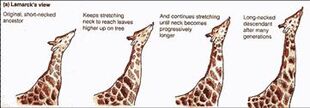
Lamarck was one of the giants upon whose shoulders Darwin stood.
Theory of Inheritance of Acquired Characteristics
Lamarck influenced Darwin with his theory of Inheritance of Acquired Characteristics. This theory was the belief that if one uses a particular trait, it can be passed down to one's ancestors. This theory had two parts. The first was use and disuse. If a trait was not used, the individual would lose it. If a trait was used, an individual could gain and retain this trait. The second part of this theory was that these traits could then be passed down to one's offspring.
As organisms become adapted to their environment, their interactions with the environment drive a change in physiological or physical needs. Lamarck's theory differs from modern evolution in that it is not due to chance. He believed that organisms continued evolutionary processes to reach "perfection". In his first book, Philosohie zoologique, he wrote:
"Nature, in producing in succession every species of animal, and beginning with the least perfect or simplest to end her work with themost perfect, has gradually complicated theirstructure".
The classic example used is that of the giraffe. The giraffe's neck gradually became longer over time as it needed it to reach leaves high in trees. Over time this would strengthen and lengthen the neck of an individual giraffe. This could then be passed down to the offspring of this giraffe.
Works Cited:[]
Inheritance of acquired characteristics. (2013). In Encyclopædia Britannica. Retrieved fromhttp://www.britannica.com/EBchecked/topic/288218/inheritance-of-acquired-characteristics
Waggoner, B. & Speer, B. (2006). Jean-Baptiste Lamarck (1744-1829). Retrieved from http://www.ucmp.berkeley.edu/history/lamarck.html